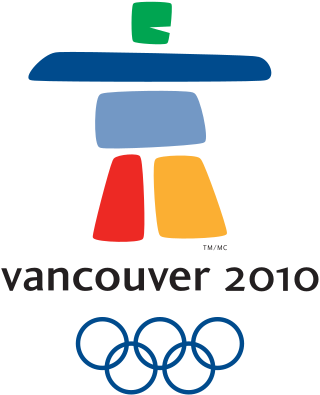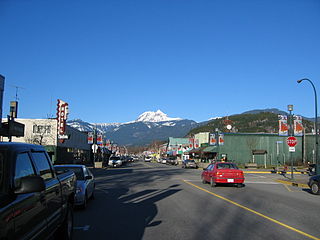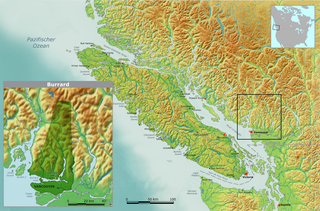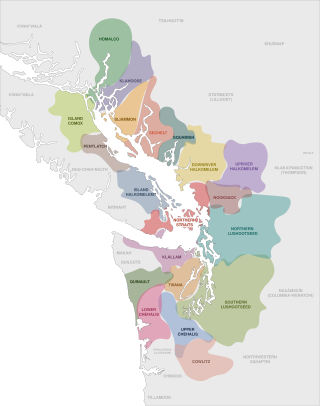Related Research Articles

Totem poles are monumental carvings found in western Canada and the northwestern United States. They are a type of Northwest Coast art, consisting of poles, posts or pillars, carved with symbols or figures. They are usually made from large trees, mostly western red cedar, by First Nations and Indigenous peoples of the Pacific Northwest Coast including northern Northwest Coast Haida, Tlingit, and Tsimshian communities in Southeast Alaska and British Columbia, Kwakwaka'wakw and Nuu-chah-nulth communities in southern British Columbia, and the Coast Salish communities in Washington and British Columbia.

The 2010 Winter Olympics, officially known as the XXI Olympic Winter Games and also known as Vancouver 2010, were an international winter multi-sport event held from February 12 to 28, 2010 in Vancouver, British Columbia, Canada, with some events held in the surrounding suburbs of Richmond, West Vancouver and the University of British Columbia, and in the nearby resort town of Whistler. It was regarded by the Olympic Committee to be among the most successful Olympic games in history, in both attendance and coverage. Approximately 2,600 athletes from 82 nations participated in 86 events in fifteen disciplines. Both the Winter Olympic and Paralympic Games were organized by the Vancouver Organizing Committee (VANOC), headed by John Furlong. The 2010 Winter Games were the third Olympics to be hosted by Canada, and the first to be held within the province of British Columbia. Canada had hosted the 1976 Summer Olympics in Montreal, Quebec, and the 1988 Winter Olympics in Calgary, Alberta.

Squamish is a community and a district municipality in the Canadian province of British Columbia, located at the north end of Howe Sound on the Sea to Sky Highway. The population of the Squamish census agglomeration, which includes First Nation reserves of the Squamish Nation although they are not governed by the municipality, is 24,232.

The Tsleil-Waututh Nation, formerly known as the Burrard Indian Band or Burrard Inlet Indian Band, is a First Nations band government in the Canadian province of British Columbia. The Tsleil-Waututh Nation ("TWN") are Coast Salish peoples who speak hən̓q̓əmin̓əm̓, the Downriver dialect of the Halkomelem language, and are closely related to but politically and culturally separate from the nearby nations of the Sḵwx̱wú7mesh (Squamish) and xʷməθkʷəy̓əm (Musqueam), with whose traditional territories some claims overlap.

The Squamish Nation is a First Nations government of the Squamish people. The Squamish Nation government includes an elected council and an administrative body based primarily in West Vancouver, North Vancouver, and Squamish, BC.
The Squamish people are an indigenous people of the Pacific Northwest Coast. Archaeological evidence shows they have lived in the area for more than a thousand years. In 2012, there was population of 3,893 band members registered with the Squamish Nation. Their language is the Squamish language or Sḵwx̱wú7mesh snichim, considered a part of the Coast Salish languages, and is categorized as nearly extinct with just 10 fluent speakers as of 2010. The traditional territory is in the area now in southwestern British Columbia, Canada, and covers Point Grey as the southern border. From here, it continues northward to Roberts Creek on the Sunshine Coast, up the Howe Sound. The northern part includes the Squamish, Cheakamus, Elaho and Mamquam rivers. Up the Cheakamus River it includes land past Whistler, British Columbia. The southern and eastern part of their territory includes Indian Arm, along Burrard Inlet, through False Creek then English Bay and Point Grey. Today the Squamish people live mostly in seven communities, located in West Vancouver, North Vancouver, and within and nearby to the District of Squamish.

Squamish is a Coast Salish language spoken by the Squamish people of the Pacific Northwest. It is spoken in southwestern British Columbia, Canada, centred on their reserve communities in Squamish, North Vancouver, and West Vancouver. An archaic historical rendering of the native Sḵwx̱wú7mesh is Sko-ko-mish but this should not be confused with the name of the Skokomish people of Washington state. Squamish is most closely related to the Sechelt, Halkomelem, and Nooksack languages.
August Jack was an Indigenous/Aboriginal chief of the Squamish people. He was born in the village of Xwayxway or Chaythoos on the peninsula that is now Stanley Park, Vancouver, British Columbia, Canada, the son of Supple Jack "Khay- Tulk" of Chaythoos and Sally "Owhaywat" from the Yekwaupsum Reserve north of Squamish, British Columbia. His grandfather was Chief Khahtsahlano of Senakw who had migrated from his home at Toktakanmic on the Squamish River to Chaythoos, and the man from whom he inherited his name. The suffix "lan-ogh" in their name means "man".

The Coast Salish are a group of ethnically and linguistically related Indigenous peoples of the Pacific Northwest Coast, living in the Canadian province of British Columbia and the U.S. states of Washington and Oregon. They speak one of the Coast Salish languages. The Nuxalk nation are usually included in the group, although their language is more closely related to Interior Salish languages.

Coast Salish art is an art unique to the Pacific Northwest Coast among the Coast Salish peoples. Coast Salish are peoples from the Pacific Northwest Coast made up of many different languages and cultural characteristics. Coast Salish territory covers the coast of British Columbia and Washington state. Within traditional Coast Salish art there are two major forms; the flat design and carving, and basketry and weaving. In historical times these were delineated among male and female roles in the community with men made "figurative pieces, such as sculptures and paintings that depicts crest, shamanic beings, and spirits, whereas women produced baskets and textiles, most often decorated with abstract designs."

The 2010 Winter Olympics Torch Relay was a 106-day run, from October 30, 2009, until February 12, 2010, prior to the 2010 Winter Olympics. Plans for the relay were originally announced November 21, 2008, by the Vancouver Organizing Committee for the 2010 Olympic and Paralympic Winter Games (VANOC). Communities were initially informed in June 2008, but the locations were not announced for "security reasons". Exact routes were later announced several weeks before the start of the torch relay.

The opening ceremony of the 2010 Winter Olympics was held on February 12, 2010, beginning at 6:00 pm PST at BC Place Stadium in Vancouver, British Columbia, Canada. This was the first Olympic opening ceremony to be held indoors. It was directed by David Atkins.

The Salish peoples are indigenous peoples of the American and Canadian Pacific Northwest, identified by their use of the Salishan languages which diversified out of Proto-Salish between 3,000 and 6,000 years ago.
Susan Point is a Musqueam Coast Salish artist from Canada, who works in the Coast Salish tradition. Her sculpture, prints and public art works include pieces installed at the Vancouver International Airport, the National Museum of the American Indian in Washington D.C., Stanley Park in Vancouver, the Museum of Anthropology at UBC, the Penn Museum in Philadelphia, and the city of Seattle.
Jody Broomfield is a Canadian artist working in the Coast Salish tradition. His work includes several coin designs for the Royal Canadian Mint.
Phil Gray is a Canadian artist who specializes in wood carvings from the Tsimshian and Mikisew Cree communities. His work uses traditional technique and features imagery from legends. In 2014, Gray was awarded a British Columbia Creative Achievement Award in Aboriginal Art from the Government of British Columbia.
Debra Sparrow, or θəliχʷəlʷət (Thelliawhatlwit), is a Musqueam weaver, artist and knowledge keeper. She is self-taught in Salish design, weaving, and jewellery making.
Xwalacktun, born Rick Harry, is a Squamish and Kwakwaka'wakw sculptor and carver. He was born and raised in Squamish, British Columbia and is known primarily for his wood carvings.
Chrystal Sparrow is a traditional and contemporary Musqueam Coast Salish artist living in Vancouver, British Columbia on unceded Coast Salish territory.
References
- ↑ "Lattimer Gallery - Artist Bio - Aaron Nelson-Moody". lattimergallery.com. Retrieved 21 August 2013.
- ↑ Fraughton, Holly (12 March 2010). "Nelson Moody carving out a niche". Pique Newsmagazine . Archived from the original on 19 February 2014.
- ↑ Lee, Jeff (16 June 2008). "First nations have key role in Games". Vancouver Sun . Archived from the original on 2 February 2014. Retrieved 16 August 2013.
- 1 2 Poon, Christopher (27 October 2011). "A different type of mountain carving". Whistler Question. Archived from the original on 2 February 2014.
- ↑ "The Spirits Within Carving Project Aaron Nelson-Moody". slcc.ca. Squamish Lil'wat Cultural Centre. Archived from the original on 4 March 2016. Retrieved 16 August 2013.
- ↑ Lee, Jeff (19 March 2008). "Turin exposure sparked lots of interest in carver". Vancouver Sun . Archived from the original on 5 November 2012.